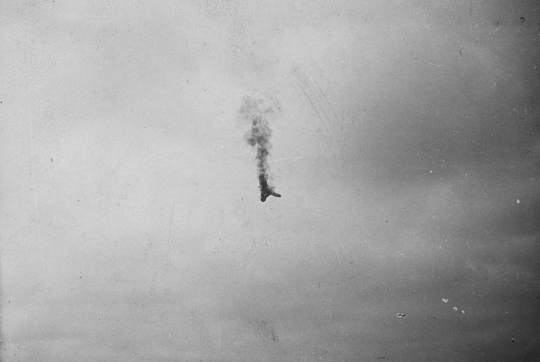Introduction
Pilots of World War I often called the aircraft they operated “flying coffins” (as shown in Figure 1). The grim nickname was a reflection of aircraft technology that was previously untested in combat and barely a decade old. By World War II, however, aircraft technology had become far more advanced in virtually every way. The new generation avoided enemy fire by flying higher and faster, and it also survived combat damage far more effectively. Stories abound of World War II pilots returning with aircraft so thoroughly perforated by enemy gunfire that they had to be scrapped after landing safely. One significant component that was largely responsible for this leap in survivability (and that is so commonplace in aircraft today that it is often taken for granted) is the self-sealing fuel tank [1].

Although the earliest iterations of self-sealing fuel containment date back to World War I, it was not until a concerted effort started in the late 1930s that a truly effective and reliable self-sealing design was established. And some designs that resulted from this effort can still be seen in the fuel tanks of today’s military aircraft. The fundamental elements, including the self-sealing mechanism, are largely unchanged. However, over the last decade, during the wars in Afghanistan and Iraq, there has been a renewed effort to improve self-sealing fuel containment technology. This article reviews self-sealing fuel containment technology from its inception through select examples of modern advanced designs.
An Elegantly Simple and Enduring Design
The inception of effective self-sealing technology was enabled by advances in rubber material processing. These innovations coincided with a rise in the demand for rubber materials in commercial and military applications leading up to World War II. In 1940, the U.S. Naval Proving Ground at Dahlgren, VA, began testing fuel tank designs provided by each of the four largest rubber manufactures at the time: Firestone Tire and Rubber Company, B. F. Goodrich Company, Goodyear Tire and Rubber Company, and U. S. Rubber Company [1]. Each of these companies, and several smaller ones, committed significant resources toward the research and development of self-sealing fuel containment technology (see Figure 2). It is therefore not surprising that two of the companies that currently produce many of the fuel tanks for modern military aircraft, Zodiac Aerospace and Meggitt, started out as spin-off companies from Firestone and Goodyear, respectively.
![Figure 2. Figures From a 1941 Patent for a “Self Sealing Fuel Tank.” Assigned to B. F. Goodrich [2]. Figure 2. Figures From a 1941 Patent for a “Self Sealing Fuel Tank.” Assigned to B. F. Goodrich [2].](/wp-content/uploads/2019/11/advances-figure2-patent.jpg)
The self-sealing technology that was developed through that effort and that has persisted through multiple wars—and despite dramatic changes in the employing aircraft—is elegantly simple. The fundamental design consists of a layer of soft rubber “sealant” that swells in the presence of fuel and that is sandwiched between two polymer layers that are impervious and insoluble to fuel. When a bullet perforates the composite lay-up and fuel begins to leak through, the sealant layer swells into the hole and stops the flow.
This simple composition and design, which are inexpensive, lightweight, and easily produced in large volumes, confronts the deceptively complex ballistic dynamics of a bullet perforating a fuel tank. When a normally oriented bullet pierces a fuel tank, it leaves a small residual hole less than the diameter of the projectile. But this small hole is just the beginning of the challenge. The bullet, travelling at 3,000 ft/s, begins to unload its tremendous kinetic energy on the fuel inside. This unloading generates a high-velocity wave of pressure in the fuel that is reflected back on the wall milliseconds after the bullet tears through. This pressure wave, known as hydrodynamic ram, blasts a jet of fuel back through the entrance wound. The bullet, still moving at a high velocity, and now followed by the same pressure wave, begins to tumble as it travels through the fuel. When it reaches the back wall of the tank, the bullet erupts sideways through the material and leaves an elongated gash that is often torn further by the trailing wake of hydrodynamic ram.
Initial fuel tank prototypes tested by Navy engineers were discouraging failures. Engineers had not anticipated the challenging dynamics, and often the entire back walls of prototype tanks were blown out by the hydrodynamic pressure wave. However, these early development tests shed some light on the mechanisms that brought down so many pilots and aircraft during the World War I. The Navy and rubber company engineers persisted and established remarkably effective design features and manufacturing processes that ultimately saved untold lives not just in World War II but in each of the armed conflicts since then.
Incremental Changes
Over the years, manufacturers have made incremental improvements to the fabrication processes and materials used in self-sealing fuel tanks. In the 1950s and ‘60s, during the South East Asia conflict, new survivability measures were implemented to reduce the likelihood of fire as a result of a ballistic impact or vehicle collision. An Air Force investigation team identified that the single most important cause of aircraft losses was fuel system fire or explosion. This finding led to key changes in aircraft fuel tank design [3].
The first change addressed the volatile fuel vapor that resides in the ullage space within the fuel tanks. The vapor can be ignited by incendiary rounds or sparks caused by impacts to metal components. The combustion of the fuel vapor can result in catastrophic structural damage as the burning vapor rapidly expands. Engineers determined that the risk of fuel vapor deflagration was effectively reduced by filling fuel tanks with low-density reticulated polyurethane foam. The foam material promotes condensation of the fuel vapor and disrupts the combustion propagation within the tank.
Engineers also significantly improved vulnerability by establishing standards to make fuel tanks “crashworthy”—meaning that the fuel tank can withstand the force of impact associated with a modest crash of 65 ft. Fuel tank manufacturers were able to meet the standards by improving their fabrication processes and incorporating layers of woven fiber reinforcement within the fuel tank wall composite lay-ups. Crashworthy fuel system design and the guiding requirements were pioneered by Dr. Harry Robertson and documented in the Military specification MIL-DTL-27422, which remains today as the guiding document for crash-resistant and ballistic-tolerant fuel tank requirements and verification testing protocols [4].
New Approaches
A new wave of fuel tank design innovation has occurred over the last two decades in response to a number of factors. The wars in Iraq and Afghanistan have highlighted the vulnerability of fuel systems in some ground vehicles. In response, ground vehicles are increasingly requiring self-sealing and blast-resistant fuel tanks for improved survivability. Department of Defense (DoD) initiatives to use more synthetic and renewable fuels are also driving innovations away from the traditional self-sealing approach. Unfortunately, these changes in fuel chemistry can diminish the efficacy of the traditional sealant materials. In addition, an ever-present desire to reduce aircraft system weight has pushed current self-sealing fuel tanks to their physical limits. Rather than trying to squeeze weight out of fuel tank designs that have been optimized over the course of 60 years, any additional lightweighting may depend upon the invention of completely novel designs.
When the first self-sealing fuel tanks were created, they employed the most advanced materials available at the time. Much has changed since 1939 in the way of materials science, particularly in the realm of polymers. High Impact Technologies LLC (HIT) has developed a design that reimagines the classic self-sealing approach with modern materials to achieve a similar self-sealing function. The technology, called BattleJacket® (shown in Figure 3), consists of layers of a custom polyurethane elastomer that sandwich a middle layer containing small fuel-imbibing beads. The beads readily swell as they absorb leaking fuel and expand to seal ballistic perforations. This self-sealing function is analogous to one provided by the soft rubber sealant in traditional self-sealing fuel tanks. A differentiating feature of the HIT design is that the system is applied by spray coating. This unique production process enables application onto the exterior of existing fuel tanks. The system has been successfully deployed in theater on fuel tanker trucks and Mine Resistant Ambush Protected (MRAP) vehicles.
![Figure 3. Exit Holes Through an Alumininum Substrate (left) and Entrance Holes Through the Opposite Side Spray-Coated With BattleJacket Material (right) [5]. Figure 3. Exit Holes Through an Alumininum Substrate (left) and Entrance Holes Through the Opposite Side Spray-Coated With BattleJacket Material (right) [5].](/wp-content/uploads/2019/11/advances-figure3-exit-holes.jpg)
Another (patent pending) approach, recently developed by the SURVICE Engineering Company, abandons the traditional principle that relies on swelling from the absorption of fuel. The sealing mechanism is self-contained and functions independently of fuel or air exposure.
As illustrated in Figure 4, two liquid reactants are contained separately in discrete cells that are embedded within the wall of the fuel tank. When a ballistic impact breaks the cells, the reactants flow together and begin to rapidly polymerize. The reaction forms a solid foam material that expands within seconds to seal the damaged area. Because the mechanism operates independently from the contained fuel type, it is effective for use with nontraditional fuels that can undermine the self-sealing capabilities of conventional self-sealing systems. Recent ballistic and crash impact testing of prototype specimens built to MIL-DTL-27422 standards has confirmed the technical feasibility but it has also indicated the need for continued development. The test specimens demonstrated an ability to seal normally oriented and tumbled small- and medium-caliber threats typically encountered by aircraft, but repeatability has not yet been fully achieved. The Joint Aircraft Survivability Program Office (JASPO) is sponsoring continued development for the promising technology.
![Figure 4. Functionality of SURVICE’s Autonomous Self-Sealing System. Layers Are Depicted in an “Exploded” View for Visibility [6]. Figure 4. Functionality of SURVICE’s Autonomous Self-Sealing System. Layers Are Depicted in an “Exploded” View for Visibility [6].](/wp-content/uploads/2019/11/advances-figure4-functionality.jpg)
Conclusions
The self-sealing fuel tanks developed prior to World War II were a landmark in aviation survivability. Their simple and reliable technology has endured for more than 60 years, even while the aircraft that use them have changed radically. But the legacy self-sealing approach is increasingly seen as an old technology that is ripe for innovation. The next generation of self-sealing fuel tanks will need to combine the steadfast reliability of the original designs while providing warfighters with critical increased survivability in air and ground vehicles as well as project managers (who must now count every fraction of an ounce) with critical weight reduction.
References:
- Eckelmeyer, Edward H. Jr. “The Story of the Self-Sealing Tank.” U.S. Naval Institute Proceedings, Vol 72/2/516, February 1946.
- Dasher, P. “Self-Sealing Fuel Tank.” B. F. Goodrich, U.S. Patent No. 2,438,965, 4 November 1941.
- Ball, Robert E.; and Dale B. Atkinson. “A History of the Survivability Design of Military Aircraft.” Naval Postgraduate School, Monterey CA, 1998.
- Robertson Fuel Systems. “Legacy of Service & Survivability.” http://www.robertsonfuelsystems.com/about/, accessed 1 May 2016.
- High Impact Technologies. “BattleJacket.” http://www.hit-usa.com/BattleJacket-sell-sheet.pdf, accessed on 1 May 1 2016.
- SURVICE Engineering Company. “Advanced Autonomous Self-Sealing Fuel Containment Technology Fact Sheet.” http://www.survice.com/uploads/attachment/advanced-autonomous-self-sealing.pdf, accessed 1 May 2016.


